Valley Fever Meningitis: Diagnosis, Treatment, and Complications
What are the symptoms of Valley Fever meningitis. How is Valley Fever meningitis diagnosed. What are the treatment options for coccidioidal meningitis. What complications can arise from Valley Fever meningitis. Why is long-term treatment necessary for coccidioidal meningitis.
Understanding Valley Fever Meningitis: A Serious Complication of Coccidioidomycosis
Valley Fever, also known as coccidioidomycosis, is a fungal infection that primarily affects the lungs. However, in some cases, the fungus can spread to other parts of the body, including the central nervous system (CNS). When this happens, it can lead to a severe condition called coccidioidal meningitis, or Valley Fever meningitis.
Coccidioidal meningitis is considered the most dangerous extrapulmonary manifestation of Valley Fever. It occurs when the Coccidioides fungi spread to the membranes surrounding the brain and spinal cord, causing inflammation and potentially life-threatening complications.

Recognizing the Symptoms of Valley Fever Meningitis
Identifying the symptoms of coccidioidal meningitis is crucial for early diagnosis and treatment. Common symptoms include:
- Persistent headaches
- Blurry vision
- Sensitivity to light (photophobia)
- Neck stiffness (meningismus)
- Cognitive decline
- Changes in hearing
- Focal neurologic deficits
Is a lumbar puncture necessary for all Valley Fever patients? A recent retrospective study suggests that routine cerebrospinal fluid (CSF) analysis is not recommended for patients in at-risk groups (based on age, ethnicity, or CF titer) who do not exhibit CNS symptoms. However, if any of the above symptoms are present, a lumbar puncture should be performed to analyze the CSF.
Diagnosing Coccidioidal Meningitis: A Comprehensive Approach
Accurate diagnosis of coccidioidal meningitis relies on a combination of clinical presentation, laboratory tests, and imaging studies. The diagnostic process typically involves:
- CSF analysis: This reveals elevated white blood cell count with mixed or lymphocytic pleocytosis, high protein levels, and low glucose levels.
- Serologic testing: Positive results from immunodiffusion (ID) or complement fixation (CF) tests in the CSF can confirm the diagnosis.
- Culture: Isolation of Coccidioides fungi from CSF samples provides definitive evidence.
- Imaging studies: These help evaluate complications associated with meningitis, such as hydrocephalus or vascular abnormalities.
How can coccidioidal meningitis be distinguished from other similar conditions? The initial features of coccidioidal meningitis may be difficult to differentiate from other etiologies, particularly tuberculosis and autoimmune illnesses. Detailed testing and a thorough clinical evaluation are essential for an accurate diagnosis.

Treatment Options for Valley Fever Meningitis: A Lifelong Commitment
Treating coccidioidal meningitis requires a long-term approach due to the high risk of relapse and potential complications. The current standard of care includes:
Antifungal Medications
Fluconazole is the preferred oral antifungal for most clinicians. The recommended dosage typically ranges from 800 to 1200 mg per day, although some studies have used doses as low as 400 mg. Treatment is generally lifelong due to the high relapse rate when therapy is discontinued.
Amphotericin B
Before the advent of azole antifungals, amphotericin B deoxycholate (AmB) was the primary treatment option. However, it required intrathecal (IT) administration due to poor efficacy when given intravenously. While less commonly used today, lipid formulations of AmB may still be employed in salvage therapy situations.
What factors influence the choice of treatment for coccidioidal meningitis? The decision between fluconazole and amphotericin B is typically based on factors such as the patient’s overall health, the severity of the infection, and potential side effects. Fluconazole is generally preferred due to its oral administration and better tolerability.

Monitoring Treatment Response and Long-Term Management
Assessing a patient’s response to therapy for coccidioidal meningitis involves:
- Regular clinical evaluations
- Monitoring of complement fixation (CF) titers
- Serial CSF analyses
- Adherence counseling
Favorable signs of improvement include:
- Return to premorbid functioning
- Decreasing CF titers
- Excellent adherence to medical care and therapy
Why is long-term treatment necessary for coccidioidal meningitis? A small study observed a 78% relapse rate when therapy was discontinued, highlighting the importance of lifelong antifungal treatment to prevent recurrence and manage the chronic nature of the infection.
Complications of Valley Fever Meningitis: Challenges in Management
Coccidioidal meningitis can lead to several life-threatening complications, including:
- Hydrocephalus
- CNS vasculitis
- Cerebral ischemia and infarction
- Vasospasm
- Hemorrhage
- Basilar meningitis
- Spinal cord involvement
How is hydrocephalus managed in patients with coccidioidal meningitis? Patients with hydrocephalus often require ventricular shunts for decompression. These shunts, typically placed in the abdominal cavity, can develop secondary complications such as infections, obstruction due to persistent coccidioidomycosis, and abdominal pseudocysts. Multiple shunt revisions may be necessary in some cases.

Challenges with Shunt Placement
Ventricular shunts, while necessary for managing hydrocephalus, can present additional complications:
- Secondary infections
- Shunt obstruction
- Formation of abdominal pseudocysts
Repeated shunt obstruction and isolation of fungus from the shunt may indicate the need for alternative antifungal therapy or a different management approach.
The Historical Perspective: Prognosis Before Modern Treatments
Understanding the historical context of coccidioidal meningitis highlights the significant advancements in treatment and prognosis:
- Before the availability of antifungal medications, coccidioidal meningitis was uniformly fatal.
- A historical series reported by Vincent et al. followed 17 patients with CM, all of whom died within 31 months.
- Combined survival statistics from five reports totaling 117 patients showed that 91% died within one year, and all patients succumbed within two years.
How has the prognosis for coccidioidal meningitis changed with modern treatments? While the fatality rate has improved significantly with the use of amphotericin B and azole antifungals, morbidity remains substantial due to disease complications, treatment-related side effects, and the need for prolonged high-dose medication regimens.

Emerging Treatments and Future Directions in Valley Fever Meningitis Management
As research in the field of fungal infections continues, new treatment options and management strategies for coccidioidal meningitis are being explored:
Combination Therapy
Some clinicians are investigating the potential benefits of combining different antifungal medications to improve efficacy and reduce the risk of drug resistance.
Immunomodulatory Approaches
Research into the immune response to Coccidioides infections may lead to new therapeutic strategies that enhance the body’s ability to fight the fungus.
Novel Drug Delivery Methods
Advances in drug delivery technologies may allow for more targeted and efficient administration of antifungal medications to the central nervous system.
What role might personalized medicine play in the treatment of coccidioidal meningitis? As our understanding of genetic factors influencing susceptibility to Valley Fever and treatment response improves, personalized treatment approaches may be developed to optimize outcomes for individual patients.

Prevention and Risk Reduction for Valley Fever Meningitis
While preventing coccidioidal meningitis specifically can be challenging, reducing the risk of Valley Fever infection is crucial:
- Avoid activities that generate dust in endemic areas
- Wear respiratory protection when exposed to dusty environments
- Stay indoors during dust storms
- Use air filtration systems in homes and workplaces
- Seek prompt medical attention for persistent respiratory symptoms in endemic regions
Can Valley Fever vaccination prevent the development of coccidioidal meningitis? Currently, there is no approved vaccine for Valley Fever. However, research is ongoing, and a successful vaccine could potentially reduce the incidence of both pulmonary coccidioidomycosis and its extrapulmonary complications, including meningitis.
The Impact of Valley Fever Meningitis on Quality of Life
Coccidioidal meningitis can have profound effects on a patient’s quality of life, extending far beyond the immediate medical concerns:

Cognitive and Neurological Effects
Patients may experience long-term cognitive impairments, memory issues, or neurological deficits that affect their daily functioning and independence.
Emotional and Psychological Impact
The chronic nature of the disease and the need for lifelong treatment can lead to anxiety, depression, and other mental health challenges.
Social and Occupational Consequences
Persistent symptoms and treatment side effects may interfere with work, relationships, and social activities, potentially leading to isolation or financial hardship.
How can healthcare providers better support the long-term well-being of patients with coccidioidal meningitis? A multidisciplinary approach involving neurologists, infectious disease specialists, mental health professionals, and social workers can help address the complex needs of patients living with this chronic condition.
Raising Awareness: The Importance of Early Detection and Treatment
Improving outcomes for patients with Valley Fever meningitis relies heavily on early detection and prompt treatment. Efforts to raise awareness among healthcare providers and the public in endemic areas are crucial:

- Education programs for primary care physicians and emergency department staff
- Public health campaigns in high-risk regions
- Integration of Valley Fever screening into routine healthcare in endemic areas
- Support for research initiatives focused on improving diagnostic tools and treatment options
What role can telemedicine play in improving access to Valley Fever expertise? Telemedicine consultations with infectious disease specialists can help bridge the gap between primary care providers in rural or underserved areas and experts in Valley Fever management, potentially leading to earlier diagnosis and more effective treatment of coccidioidal meningitis.
Coccidioidal Meningitis | UC Davis Center for Valley Fever
Skip to main content
Center for Valley Fever
News | Careers | Giving | UC Davis Health
- UC Davis Health
- Center for Valley Fever
- About Valley Fever
The most deleterious extrapulmonary dissemination is the spread of Coccidioides spp. to the central nervous system (CNS) causing meningitis. A lumbar puncture with analysis of cerebrospinal fluid (CSF) should be done in any patient with suspected or previously diagnosed coccidioidomycosis presenting with a headache, blurry vision, photophobia, meningismus, decline in cognition, hearing changes, and focal neurologic deficit. As illustrated in a recent retrospective study there is no evidence to support routine CSF analysis in patients in at-risk groups (age, ethnicity, CF titer, etc. ) if they do not have CNS symptoms (1). The diagnosis of CM is based on a positive serologic testing (ID/CF) or culture of CSF. CSF analysis typically shows an elevated white blood cell count with a mixed or lymphocytic pleocytosis, a high level of protein (sometimes measurable in g/dL rather than mg/dL), and a low level of glucose. Imaging studies are helpful in evaluating complications associated with meningitis. Initial features of illness may be difficult to distinguish from other etiologies without detailed testing, notably tuberculosis and even autoimmune illnesses.
) if they do not have CNS symptoms (1). The diagnosis of CM is based on a positive serologic testing (ID/CF) or culture of CSF. CSF analysis typically shows an elevated white blood cell count with a mixed or lymphocytic pleocytosis, a high level of protein (sometimes measurable in g/dL rather than mg/dL), and a low level of glucose. Imaging studies are helpful in evaluating complications associated with meningitis. Initial features of illness may be difficult to distinguish from other etiologies without detailed testing, notably tuberculosis and even autoimmune illnesses.
When left untreated, CM is uniformly fatal (2). In a historical series reported by Vincent et al, before the availability of antifungals, seventeen patients with CM were followed all of whom died within 31 months (2). This review also commented on the combined survival statistics described in five reports of 117 patients where 91% of patients with CM died within one year and all died within 2 years. Though the fatality has improved with the use of AmB and azoles, morbidity is still substantial due to complications from the disease, devices used for treatment management, and side effects of the medications as much higher recommended doses are necessary for prolonged period of time (3).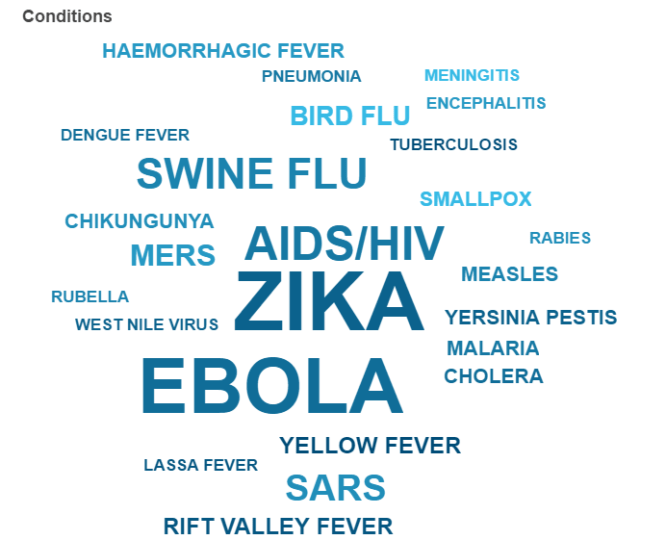
The most common life-threatening complications of meningitis include hydrocephalus, CNS vasculitis, cerebral ischemia, infarction, vasospasm and hemorrhage. Basilar meningitis and spinal cord involvement may also be encountered. In patients with hydrocephalus, a ventricular shunt is necessary for decompression. Such shunts, often placed distally into the abdominal cavity may develop secondary infections, obstruction due to persistent coccidioidomycosis, and/or abdominal pseudocysts (4). It is not uncommon for patients to require multiple shunt revisions. As illustrated in several case reports, repeated obstruction of the shunt and isolation of fungus should alert one to seek alternate antifungal therapy. Some clinicians have used steroids for vasculitis though this is considered anecdotal.
For treatment of CM, most clinicians prefer therapy with oral fluconazole (5). Although the dose studied in an uncontrolled clinical trial was 400 mg, it is common to begin therapy with 800 to 1200 mg per day of fluconazole (3, 6).:max_bytes(150000):strip_icc()/menigitis_symptoms-5b0d5dbd0e23d90036bd6770.jpg) Prior to the advent of azoles, amphotericin B deoxycholate (AmB) was the only drug of choice but was ineffective when given intravenously and required frequent administrations via the intrathecal (IT) route. Due to challenges of administration, toxicity associated with this route and lack of experience in utilizing this method, current practitioners seldom resort to recommending AmB as initial therapy although lipid formulations have been used in the salvage setting successfully (7). Though there are no trials comparing IT AmB and fluconazole, the response rate of IT AmB has ranged from 51%-100% in studies published before 1986 and with fluconazole the rate is near 79% (6, 8). With fluconazole symptoms resolve within 4-8 months though there is a delay in normalization of CSF abnormalities which may persist in the presence of a shunt. Based on clinical experience and due to an extremely high relapse of 78% noted in a small series when therapy is discontinued, lifelong treatment with azoles is recommended (9).
Prior to the advent of azoles, amphotericin B deoxycholate (AmB) was the only drug of choice but was ineffective when given intravenously and required frequent administrations via the intrathecal (IT) route. Due to challenges of administration, toxicity associated with this route and lack of experience in utilizing this method, current practitioners seldom resort to recommending AmB as initial therapy although lipid formulations have been used in the salvage setting successfully (7). Though there are no trials comparing IT AmB and fluconazole, the response rate of IT AmB has ranged from 51%-100% in studies published before 1986 and with fluconazole the rate is near 79% (6, 8). With fluconazole symptoms resolve within 4-8 months though there is a delay in normalization of CSF abnormalities which may persist in the presence of a shunt. Based on clinical experience and due to an extremely high relapse of 78% noted in a small series when therapy is discontinued, lifelong treatment with azoles is recommended (9).
Assessing a patient’s response to therapy is primarily a matter of serial evaluation and clinical judgment. Favorable signs include return to premorbid functioning, decreasing CF titers, and excellent adherence to medical care and therapy. Some patients with chronic meningitis have refractory illness with poor recovery or exceptionally slow improvement. A combination of serology and repeated CSF evaluation may be necessary to assess microbiologic and serologic improvement. Adherence counseling, assessment of drug-drug interactions, therapeutic drug monitoring, and consideration of alternative antifungal therapy may be necessary. For CM patients who are failing treatment and/or have refractory coccidioidal disease, salvage regimens may be necessary. Both voriconazole and posaconazole have been used in this situation, with a growing body of case series and clinical experience to support their use.
REFERENCES
- Thompson G, 3rd, Wang S, Bercovitch R, et al. Routine CSF Analysis in Coccidioidomycosis Is Not Required.
 PloS one 2013; 8(5): e64249.
PloS one 2013; 8(5): e64249. - Vincent T, Galgiani JN, Huppert M, Salkin D. The natural history of coccidioidal meningitis: VA-Armed Forces cooperative studies, 1955-1958. Clin Infect Dis 1993; 16(2): 247-54.
- Johnson RH, Einstein HE. Coccidioidal meningitis. Clinical infectious diseases : an official publication of the Infectious Diseases Society of America 2006; 42(1): 103-7.
- Hibbett DS, Binder M, Bischoff JF, et al. A higher-level phylogenetic classification of the Fungi. Mycol Res 2007; 111(Pt 5): 509-47.
- Galgiani JN, Ampel NM, Blair JE, et al. Coccidioidomycosis. Clinical infectious diseases : an official publication of the Infectious Diseases Society of America 2005; 41(9): 1217-23.
- Galgiani JN, Catanzaro A, Cloud GA, et al. Fluconazole therapy for coccidioidal meningitis. The NIAID-Mycoses Study Group. Annals of internal medicine 1993; 119(1): 28-35.
- Mathisen G, Shelub A, Truong J, Wigen C. Coccidioidal meningitis: clinical presentation and management in the fluconazole era.
 Medicine 2010; 89(5): 251-84.
Medicine 2010; 89(5): 251-84. - Bouza E, Dreyer JS, Hewitt WL, Meyer RD. Coccidioidal meningitis. An analysis of thirty-one cases and review of the literature. Medicine 1981; 60(3): 139-72.
- Dewsnup DH, Galgiani JN, Graybill JR, et al. Is it ever safe to stop azole therapy for Coccidioides immitis meningitis? Annals of internal medicine 1996; 124(3): 305-10.
Valley fever – Symptoms & causes
Overview
Valley fever is a fungal infection caused by coccidioides (kok-sid-e-OY-deze) organisms. It can cause signs and symptoms such as a fever, cough and tiredness.
Two coccidioides fungi species cause valley fever. These fungi are commonly found in soil in specific regions. The fungi’s spores can be stirred into the air by anything that disrupts the soil, such as farming, construction and wind.
People can then breathe the fungi into their lungs. The fungi can cause valley fever, also known as acute coccidioidomycosis (kok-sid-e-oy-doh-my-KOH-sis). Mild cases of valley fever usually resolve on their own. In more-severe cases, doctors treat the infection with antifungal medications.
Mild cases of valley fever usually resolve on their own. In more-severe cases, doctors treat the infection with antifungal medications.
Products & Services
Symptoms
Valley fever is the initial form of coccidioidomycosis infection. This initial, acute illness can develop into a more serious disease, including chronic and disseminated coccidioidomycosis.
Acute coccidioidomycosis (valley fever)
The initial, or acute, form of coccidioidomycosis is often mild, with few or no symptoms. Signs and symptoms occur one to three weeks after exposure. They tend to be similar to flu symptoms. Symptoms can range from minor to severe, including:
- Fever
- Cough
- Tiredness
- Shortness of breath
- Headache
- Chills
- Night sweats
- Joint aches and muscle soreness
- Red, spotty rash, mainly on lower legs but sometimes on the chest, arms and back
If you don’t become ill or have symptoms from valley fever, you may only find out you’ve been infected later. You may find out when you have a positive skin or blood test or when small areas of residual infection in the lungs (nodules) show up on a routine chest X-ray. The nodules typically don’t cause problems, but they can look like cancer on X-rays.
You may find out when you have a positive skin or blood test or when small areas of residual infection in the lungs (nodules) show up on a routine chest X-ray. The nodules typically don’t cause problems, but they can look like cancer on X-rays.
If you develop symptoms, especially severe ones, the course of the disease is highly variable. It can take months to fully recover. Fatigue and joint aches can last even longer. The disease’s severity depends on several factors, including your overall health and the number of fungus spores you inhale.
Chronic coccidioidomycosis
If the initial coccidioidomycosis infection doesn’t completely resolve, it may progress to a chronic form of pneumonia. This complication is most common in people with weakened immune systems.
Signs and symptoms include:
- Low-grade fever
- Weight loss
- Cough
- Chest pain
- Blood-tinged sputum (matter discharged during coughing)
- Nodules in the lungs
Disseminated coccidioidomycosis
The most serious form of the disease, disseminated coccidioidomycosis, is uncommon. It occurs when the infection spreads (disseminates) beyond the lungs to other parts of the body. Most often these parts include the skin, bones, liver, brain, heart, and the membranes that protect the brain and spinal cord (meninges).
It occurs when the infection spreads (disseminates) beyond the lungs to other parts of the body. Most often these parts include the skin, bones, liver, brain, heart, and the membranes that protect the brain and spinal cord (meninges).
Signs and symptoms of disseminated disease depend on the body parts affected and may include:
- Nodules, ulcers and skin lesions that are more serious than the rash that sometimes occurs with initial infection
- Painful lesions in the skull, spine or other bones
- Painful, swollen joints, especially in the knees or ankles
- Meningitis — an infection of the membranes and fluid surrounding the brain and spinal cord
When to see a doctor
Seek medical care if you are over 60, have a weakened immune system, are pregnant, or are of Filipino or African heritage, and you develop the signs and symptoms of valley fever, especially if you:
- Live in or have recently traveled to an area where this disease is common
- Have symptoms that aren’t improving
Be sure to tell your doctor if you’ve traveled to a place where valley fever is common and you have symptoms.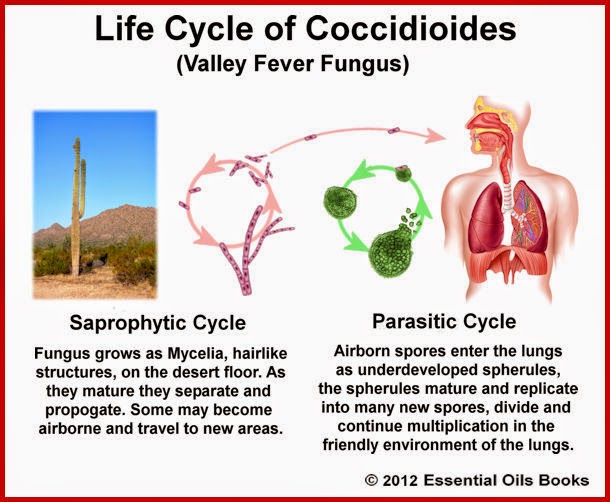
Causes
Valley fever is caused by a person inhaling spores of certain fungi. The fungi that cause valley fever — Coccidioides immitis or Coccidioides posadasii — live in the soil in parts of Arizona, Nevada, Utah, New Mexico, California, Texas and Washington. It’s named after the San Joaquin Valley in California. The fungi can also often be found in northern Mexico and Central and South America.
Like many other fungi, coccidioides species have a complex life cycle. In the soil, they grow as a mold with long filaments that break off into airborne spores when the soil is disturbed. A person can then inhale the spores.
The spores are extremely small and can be carried far by the wind. Once inside the lungs, the spores reproduce, continuing the disease cycle.
Risk factors
Risk factors for valley fever include:
Environmental exposure. Anyone who inhales the spores that cause valley fever is at risk of infection.
 People who live in areas where the fungi are common — especially those who spend a lot of time outdoors — have a greater risk.
People who live in areas where the fungi are common — especially those who spend a lot of time outdoors — have a greater risk.Also, people who have jobs that expose them to dust are most at risk — construction, road and agricultural workers, ranchers, archaeologists, and military personnel on field exercises.
- Race. For reasons that aren’t well understood, people of Filipino and African heritage are more susceptible to developing serious fungal infections.
- Pregnancy. Pregnant women are vulnerable to more-serious infections when they get the infection during the third trimester. New mothers are vulnerable right after their babies are born.
- Weakened immune system. Anyone with a weakened immune system is at increased risk of serious complications. This includes people living with acquired immunodeficiency syndrome (AIDS) or those being treated with steroids, chemotherapy and anti-rejection drugs after transplant surgery. People with certain autoimmune diseases, such as rheumatoid arthritis or Crohn’s disease, who are being treated with anti-tumor necrosis factor (TNF) drugs also have an increased risk of infection.

- Diabetes. People with diabetes may have a higher risk of severe lung infections.
- Age. Older adults are more likely to develop valley fever. This may be because their immune systems are less robust or because they have other medical conditions that affect their overall health.
Complications
Some people, especially pregnant women, people with weakened immune systems — such as those living with human immunodeficiency virus (HIV)/AIDS — and those of Filipino or African heritage are at risk of developing a more severe form of coccidioidomycosis.
Complications of coccidioidomycosis may include:
- Severe pneumonia. Most people recover from coccidioidomycosis-related pneumonia without complications. Others, such as people of Filipino and African heritage, and those with weakened immune systems, may become seriously ill.
- Ruptured lung nodules.
 A small percentage of people develop thin-walled nodules (cavities) in their lungs. Many of these eventually disappear without causing any problems, but some may rupture, causing chest pain and difficulty breathing. A ruptured lung nodule might require the placement of a tube into the space around the lungs to remove the air or surgery to repair the damage.
A small percentage of people develop thin-walled nodules (cavities) in their lungs. Many of these eventually disappear without causing any problems, but some may rupture, causing chest pain and difficulty breathing. A ruptured lung nodule might require the placement of a tube into the space around the lungs to remove the air or surgery to repair the damage. - Disseminated disease. This is the most serious complication of coccidioidomycosis but it’s uncommon. If the fungus spreads (disseminates) throughout the body, it can cause problems including skin ulcers, abscesses, bone lesions, severe joint pain, heart inflammation, urinary tract problems and meningitis — a potentially fatal infection of the membranes and fluid covering the brain and spinal cord.
Prevention
There is no vaccine to prevent valley fever.
If you live in or visit areas where valley fever is common, take common-sense precautions, especially during the dry season following a rainy season when the chance of infection is highest.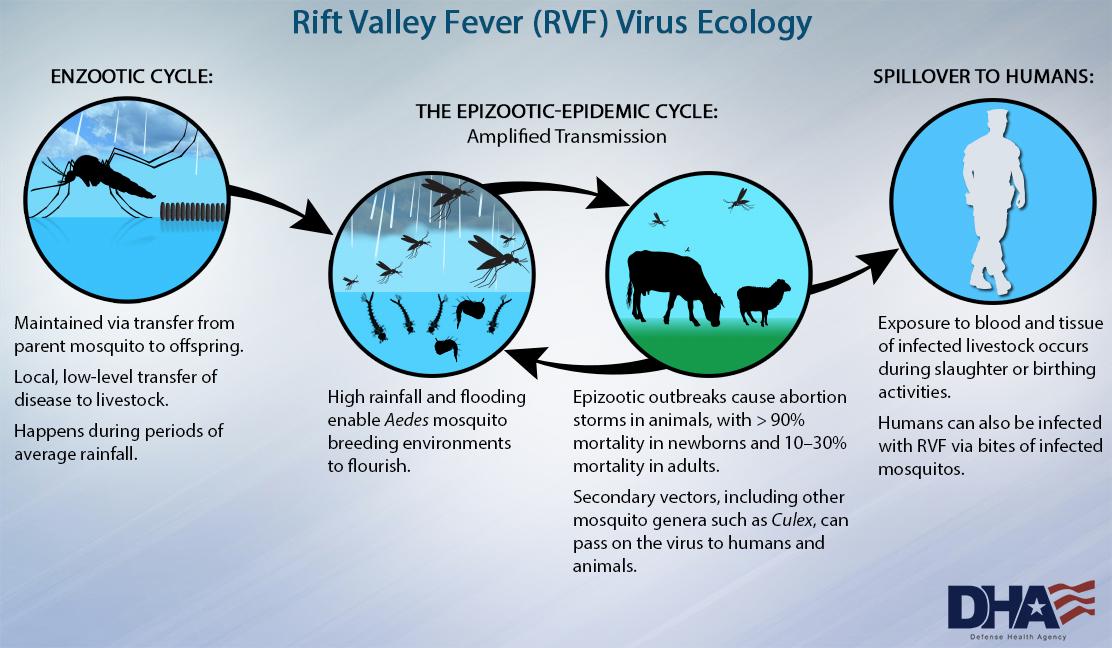
Consider these tips:
- Wear a mask.
- Avoid very dusty areas, such as construction sites.
- Stay inside during dust storms.
- Wet the soil before digging in it, or avoiding soil if you’re at higher risk of infection.
- Keep doors and windows tightly closed.
- Clean skin injuries with soap and water.
US drought resurrects fungus that causes fever and meningitis
Society
2864
Share
Photo: Global Look Press
Fires, floods and the record sting of 2022 certainly pose a great danger to human health. But dry weather in the United States in California has brought to life a disease-causing fungus that spreads by airborne droplets.
But dry weather in the United States in California has brought to life a disease-causing fungus that spreads by airborne droplets.
It’s called Coccidioides, and it causes Valley Fever. Its symptoms are crushing headaches and sinus infections. Worst of all, it can turn into meningitis.
Former financial planner and father of two, Rob Purry, first contracted a fever and then contracted meningitis. He complained that the illness had taken away all his health and all the money the family had.
Coccidioides requires a dry and hot climate to survive. Therefore, the disease, originally characteristic of the hot plains of California, is becoming more common. This was announced by infectious disease expert Dr. Royce Johnson.
Most of the western US is already in drought, added Morgan Gorris, an Earth system researcher at Los Alamos National Laboratory.
“The western half of the US is still expected to be fairly dry and Valley Fever is expected to spread,” he predicted.
It is important to note that soil, if left undisturbed, will not necessarily lead to inhalation of the disease. But any disturbance to the layer, whether it be a full-scale archaeological site or a burrowing animal, will release the fungus from the soil. Pathogenic spores can travel up to 75 miles (120 km).
Scientists recently warned that the next global pandemic could be fungal. Therefore, the growing spread of Coccidioides is of particular concern.
See also: “The number of cases of monkeypox infection in the world has exceeded 50 thousand”
Subscribe
Authors:
- org/Person”>
Anastasia Kukova
US
What else to read
What to read:More materials
In the regions
A tourist spoke about a traffic jam in front of the Crimean bridge: even children are being searched
34512
Crimea
photo: MK in Crimea
British visionaries: APU will enter the Crimea in a month
11298
Crimea
crimea.
 mk.ru
mk.ru
photo: MK in CrimeaCrimean Maldives: how the holiday season goes on the coolest beaches
Photo
10825
Crimea
Valeria Rudnik, photo by the author
July 7 is the day of Ivan Kupala, what is possible and what is strictly forbidden to do on a big holiday
Photo
9063
Pskov
What caused the worst railway accident in Karelia
Photo
8843
Karelia
Alexander Trubin
In Novosibirsk, the girl abandoned the child after the betrayal of her husband
4258
Novosibirsk
Daria Melekhova
In the regions:More materials
A rare type of meningitis for which there is no vaccine.
 All About Fungal Meningitis
All About Fungal Meningitis
Fungal meningitis is an inflammation and infection of the membranes surrounding the brain and spinal cord.
There are different types of meningitis, including viral, bacterial and fungal. Of these, the latter, for example, is the rarest in the United States.
Fungal meningitis occurs when a fungus that has invaded another area of the body travels to the brain or spinal cord. Various types of fungi can cause fungal meningitis.
Types of fungal meningitis
Fungal meningitis is divided into types according to the type of fungus causing the infection. There are five types of fungal meningitis.
1. Cryptococcus Neoformans
Cryptococcus Neoformans is a type of fungus found throughout the world:
- in soil,
- bird droppings,
- rotting wood.
People can inhale the fungus after being in close contact with soil or other materials that contain it, but most people who are exposed to Cryptococcus neoformans do not get sick. However, it is the most common form of fungal meningitis, accounting for more than 70% of cases of fungal meningitis.
However, it is the most common form of fungal meningitis, accounting for more than 70% of cases of fungal meningitis.
People with weakened immune systems are more likely to have a Cryptococcus neoformans infection, which can present as a lung infection or meningitis, depending on where in the body the infection occurs.
Cryptococcus neoformans infections are particularly common in people with advanced HIV/AIDS.
2. Coccidioides
Coccidioides is a fungus found in the soil of the southwestern United States, Washington State, Mexico, South America and Central America.
Coccidioidosis causes a condition called valley fever, or coccidioidomycosis. Valley fever can affect anyone and can take months to resolve. People with weakened immune systems are more likely to have severe cases, which can include meningitis.
Coccidioides is responsible for approximately 16% of cases of fungal meningitis.
3. Candida
Candida, better known as yeast, is a fungus that occurs naturally in the body but can cause an infection if it grows too fast or gets into an area of the body it shouldn’t – for example, into the meninges.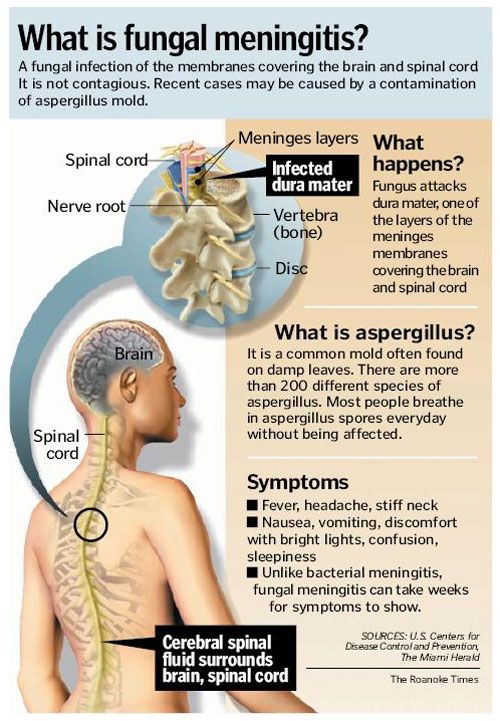
Some yeast infections, such as vaginal yeast infection or thrush, are localized to one area of the body, but forms of yeast infections or candidiasis can be invasive. Invasive candidiasis can enter the circulatory system and cause symptoms throughout the body.
About 8% of cases of fungal meningitis are associated with candidiasis.
4. Histoplasma
Histoplasma is a fungus found in bird and bat droppings, especially in the Ohio and Mississippi river valleys, although the fungus can be found far beyond this area.
Histoplasm causes an infection called histoplasmosis, which may include meningitis. Anyone can develop histoplasmosis, and in most cases the condition will go away on its own. However, people with suppressed immune systems are more likely to experience severe cases, including meningitis.
About 6% of cases of fungal meningitis are caused by histoplasma.
5. Blastomyces
Blastomyces is a fungus found in decaying leaves and wood, and in moist soil, especially in the Mississippi River Valley, Ohio River Valley, and Great Lakes regions of the United States.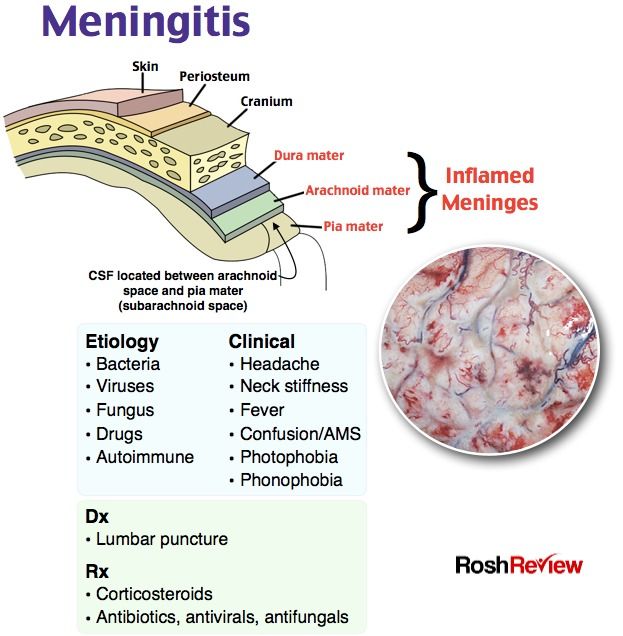
Blastomycetes can cause an infection called blastomycosis. In most cases, there are no symptoms. However, this type of fungal meningitis is rare.
Symptoms of fungal meningitis
The symptoms of fungal meningitis are the same as the general symptoms of meningitis. These include fever, headache, and neck stiffness, especially when they occur at all. However, the temperature can be below 37.7°C, making it difficult to detect.
Other common symptoms of meningitis include:
- Pain
- Fatigue, drowsiness and trouble waking up
- Lack of appetite
- Nausea and vomiting
- Irritability and mood changes
Causes of fungal meningitis
Fungal meningitis occurs when a person is exposed to a fungus (usually by inhaling it), which then causes an infection in the body. Living in areas exposed to harmful fungi can increase your risk of contracting fungal meningitis. However, people with underlying medical conditions or weakened immune systems are most at risk.
Risk factors
People with weakened immune systems are more likely to get fungal meningitis, as mentioned above. A weakened immune system may be due to:
- Health conditions such as HIV or cancer
- Medicines such as steroids, immunosuppressants and TNF inhibitors
- Various health conditions
- Premature babies are also at higher risk of fungal infections, especially Candida.
Diagnosis
If meningitis is suspected, the doctor will order a blood test and a lumbar puncture, in which cerebrospinal fluid is removed from the spine. Using these samples, the doctor will be able to determine the cause of the infection. This is especially important in the case of fungal meningitis, as the type of fungus you are exposed to will determine the course of treatment.
Treatment of fungal meningitis
Antifungal drugs will be used to treat fungal infections of the nervous system, including fungal meningitis.

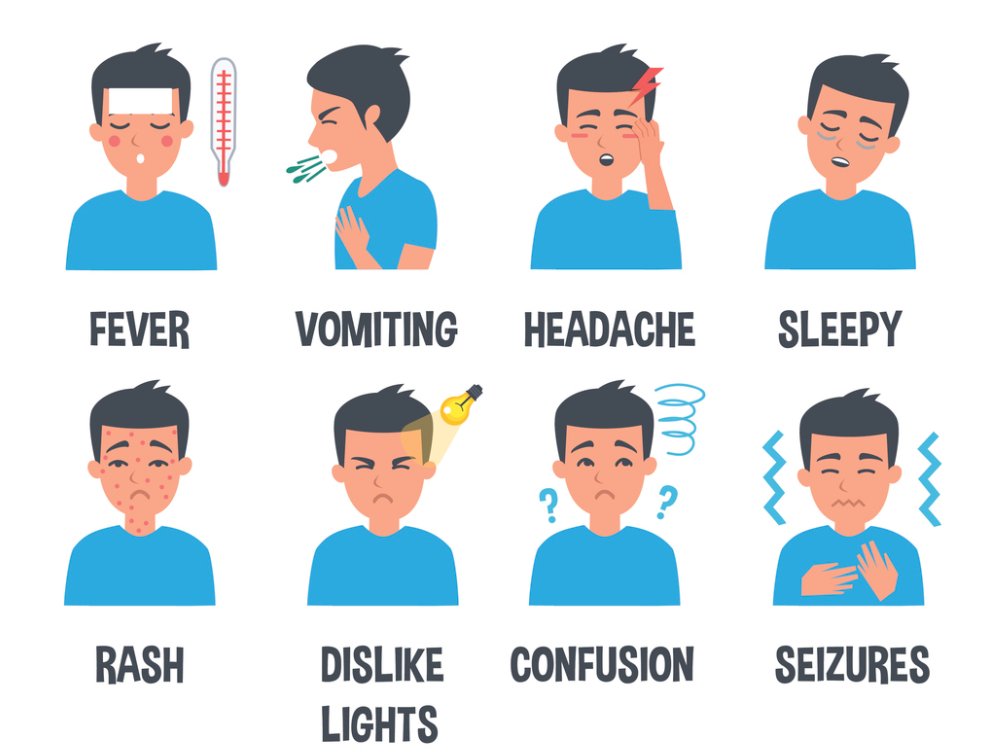 PloS one 2013; 8(5): e64249.
PloS one 2013; 8(5): e64249. Medicine 2010; 89(5): 251-84.
Medicine 2010; 89(5): 251-84. People who live in areas where the fungi are common — especially those who spend a lot of time outdoors — have a greater risk.
People who live in areas where the fungi are common — especially those who spend a lot of time outdoors — have a greater risk.
 A small percentage of people develop thin-walled nodules (cavities) in their lungs. Many of these eventually disappear without causing any problems, but some may rupture, causing chest pain and difficulty breathing. A ruptured lung nodule might require the placement of a tube into the space around the lungs to remove the air or surgery to repair the damage.
A small percentage of people develop thin-walled nodules (cavities) in their lungs. Many of these eventually disappear without causing any problems, but some may rupture, causing chest pain and difficulty breathing. A ruptured lung nodule might require the placement of a tube into the space around the lungs to remove the air or surgery to repair the damage. mk.ru
mk.ru